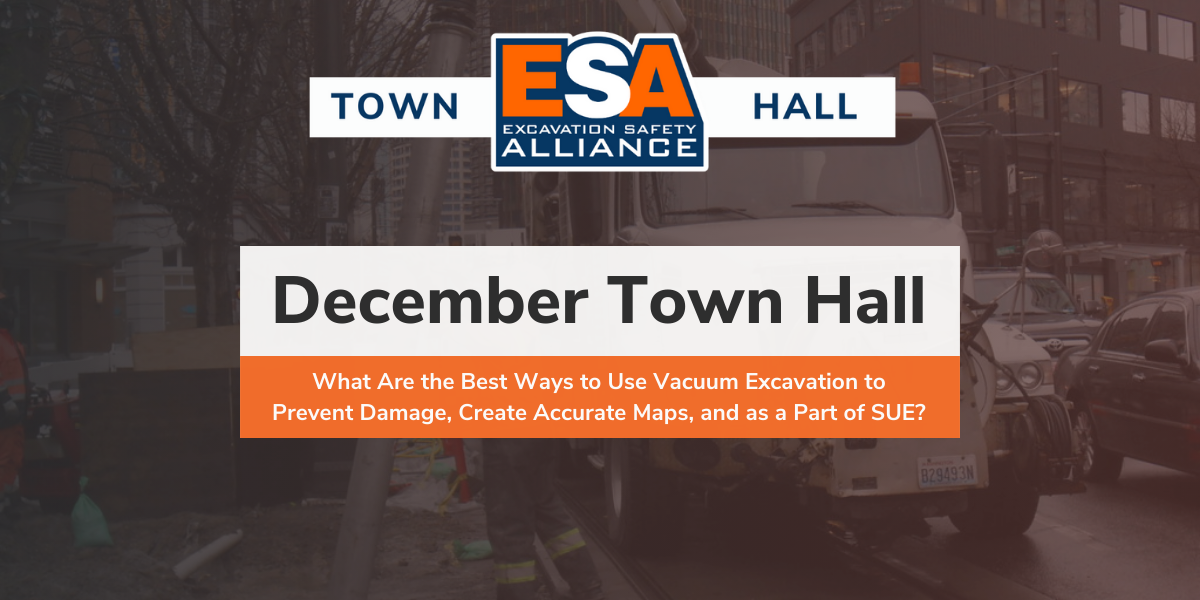
Hello Readers,
In our recent Town Hall, the spotlight shone on an exciting ongoing revolution brewing beneath our feet: vacuum excavation. Imagine a world where delicate excavation replaces disruptive trenching, where damage to buried utilities becomes a relic of the past, and where precise mapping guides every dig with ease. Vacuum excavation can’t achieve this reality on its own, but it is certainly part of that vision. Our panel of experts shed light on the potential of vacuum excavation going forward as well discussing its pros and cons.
Our participants for this Town Hall included:
Moderator: Ron Peterson, Executive Director, Nulca
Panelists:
- Bob Basques, Technical Director, SharedGeo
- Kemp Garcia, Project Manager, Linescape of WA
- Jerry Hoover, Director, National Accounts Sales & Training, Badger Infrastructure Solutions
- Dustin Rhodes, Product Manager, Federal Signal
They addressed a wide variety of questions from our moderator, Ron Peterson, such as:
- How has the adoption of vacuum excavation positively impacted the prevention of damages to underground utilities?
- Are there specific regulations or standards that endorse or require the use of vacuum excavation in utility projects?
- How does the risk of a utility damage using traditional excavation methods compare to the risk when employing vacuum excavation, and what factors influence this assessment?
- Can you share examples where the use of vacuum excavation has proven to be more cost-effective in comparison to traditional excavation methods?
- What methods can be employed to retrieve engineering data and plans for locating underground features in the field?
- How has technology evolved in the field of vacuum excavation, and what innovative features or advancements contribute to its effectiveness in preventing damage?
Our audience members weren’t lacking either and provided the following questions that are panelists tackled as well:
- We are doing a water service line inventory; do we need to call in locates in order to daylight our own utilities?
- Do you ever see a day when the 811 will be replaced by SUE and digital mapping?
- Do you feel that 811 should be called for vacuum excavation work? And if yes, why?
- When can we implement hydro-excavation processes that allow for the reuse of excavated soil within the hole, eliminating the need to bring in additional soil for backfilling?
- What safety innovations is the industry looking at to make the trucks safer and to push the industry forward?
- Do you find that the additional encroachment permit (with traffic plan, etc.) serves as a deterrent for project owners to want vacuum excavation in advance of construction
- What are the advantages and disadvantages of hydro versus vacuum excavation?
- Are you finding it difficult to find CDL drivers for your Vac Trucks?
- Do VAC providers know what test pit requirements are necessary to be considered SUE Level A?
- Have you tried to provide GPS coordinates to the operators of facilities that you find? In California, facility owners often don't want to accept 3rd party coordinates (partly because of land surveyor laws).
- How do Vac truck practitioners deal with abandoned lines you find?
Here is a brief recap of our participants key takeaways:
Dustin Rhodes: Vacuum excavation is the safest method, regardless of air or water usage. Always remember to call 811 and understand your local legislation.
Jerry Hoover: Vacuum excavation is cost-effective, keeping projects on schedule, under budget, and out of the news. It's essential for avoiding negative publicity and legal troubles.
Kemp Garcia: Accurate SUE practices are crucial for cost reduction and project efficiency. More municipalities and private entities need to adopt SUE to avoid unforeseen hazards and bid projects accurately.
Bob Basques: Integrating digital data and sensors with field equipment like shovels holds immense potential for future improvements. More data collection and sharing will contribute to safer and more efficient excavations.
Ron Peterson: Vacuum excavation plays a vital role in construction, excavation, and planning. Accurate plans and data sharing pave the way for a safer and more effective future in underground work.
Want to hear the answers to all of the above questions and more? View the full Town Hall.
Curious to see what everything that was discussed in the chat? View the Chat Log.
Mark your calendars for our next Town Hall on January 11th, where we'll tackle the thorny issue of abandoned lines. Visit the Town Hall page to register.
